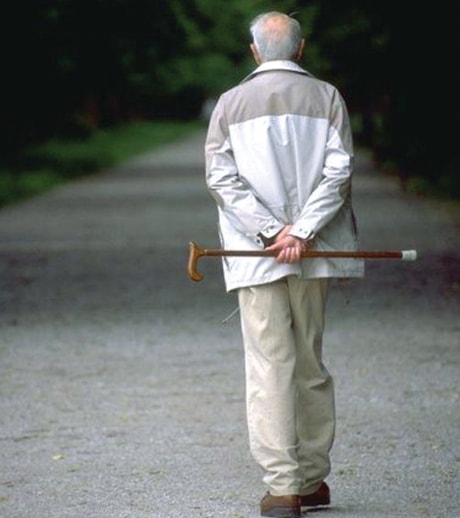WASHINGTON — Tom Dougherty jokes that he takes “get-lost walks.” To his wife, Cleo, it’s a constant fear: When will his Alzheimer’s get bad enough that she has to end his 6.5-kilometre daily strolls?
The Irvine, Calif., woman is about to watch her husband’s neighbourhood meandering via computer while she works.
The Alzheimer’s Association is adapting technology developed for monitoring prisoners to let caregivers track where their loved ones drive or walk — and alert them if they go beyond the virtual fences each family can set.
“You’re trying to help them maintain their dignity and independence,” says Cleo Dougherty, who pilot-tested the service with her 67-year-old husband last summer and is awaiting arrival of the official version, which began shipping transmitters last week.
More than five million Americans are estimated to be living with Alzheimer’s, as many as half in the disease’s early stages.
In Canada, the Alzheimer Society estimates that 420,600 Canadians over 65 have the disease and related dementias.
As techniques for diagnosis get better, doctors are discovering increasing numbers of younger adults showing symptoms of early-onset dementia.
Increasingly early diagnosis means many patients still have years of independent living ahead of them before they have to give up the car, and eventually give up going out alone at all.
At some point, nearly 60 per cent of Alzheimer’s patients will begin what’s called wandering, requiring more intense supervision to keep them safe.
A growing number of states are adopting “Silver Alerts” programs that notify the public when an Alzheimer’s patient or other cognitively impaired adult wanders off, modelled on the Amber Alerts for missing children.
Other families opt for higher-tech options — from simple radio-wave beacons to more sophisticated GPS technology — developed for search-and-rescue that allow tracking a transmitter signal if the person carrying the device is missing.
“That works great when they’re lost, but until they’re lost it isn’t really helping families manage location,” says the Alzheimer’s Association’s Beth Kallmyer.
So the association’s new Comfort Zone program goes a step further, with a web-based mapping service that works with multiple brands of tracking transmitters.
First out are a pocket-size transmitter and a car version, while a harder-to-remove wristwatch style and one secreted in shoes are being explored.
Families can check where Dad is at any given time, or in an emergency track his movements every two minutes while someone heads him off.
Or families might set day- and night-time perimeters for Aunt Sue. Cross the zone and an email or text message alerts the caregivers. That might mean a call to her cellphone to see if she needs directions — or it might just be useful information in judging how well she gets around on her own.
How it works: The Alzheimer’s Association hired Omnilink Services, best known for prisoner monitoring, to run the web mapping with various types of technology. Different manufacturers’ transmitters are certified as compatible. Families buy a transmitter for about US$200, and then choose a monthly monitoring plan that can range from US$43 to US$80.
That’s far cheaper, says Cleo Dougherty, than the Alzheimer’s day program she’ll have to enrol her husband in once he can’t walk his neighbourhood alone.
A few small companies attempted similar Alzheimer’s tracking a few years ago before the technology could keep pace, says University of Rochester assisted-cognition specialist Henry Kautz, who isn’t involved with the Alzheimer’s Association.
The accuracy of GPS, for instance, depends on clear access to satellites powering the navigation tool, meaning a tunnel or tall buildings can block signals. Today’s “network-assisted GPS” can pair GPS with nearby cellphone towers to improve reliability, Kautz said.
“This is going to be a big hit,” Kautz said of Comfort Zone, largely because “a trusted non-profit” will be an umbrella for multiple choices.
The technology is not a replacement for in-person supervision, cautioned Nina Silverstein, a gerontology professor at the University of Massachusetts, Boston.
But pilot-testing Comfort Zone gave Karen Zimmerman’s husband peace of mind. The Alexandria, Va., woman was diagnosed with Alzheimer’s at the unusually young age of 51, and nearly two years later still drives on her own every day for volunteer work and to shop.
Independence is “the most important thing to me right now, it really is. If I had to sit here at the house all day, I don’t know what I would do,” says Zimmerman.
She does get “very flustered” on the few occasions she’s gotten turned around, says husband Keith Holdsworth, who wants a new Comfort Zone transmitter on her car before the couple’s next trip to the out-of-state retirement home they’re building, where even he finds the unfamiliar roads confusing.
“It’ll get to the point where I’ll need to rein her in,” Holdsworth says. But the service “will afford her that independence for a longer period of time.”
On the Net:
Alzheimer’s Association: http://www.alz.org/comfortzone
